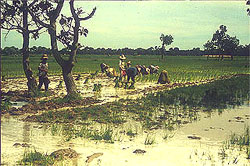2. The Area Studies Approach Normally, one would think that the subject of such a project would lie in the domain of those who specialize in agricultural science. Rapid headway has been made in research on environmental monitoring and assessment of agricultural productivity, in the field of remote sensing, whose primary source of information is satellite images. Under these circumstances, what contribution can area studies make? This type of question is always in the minds of those of us in the field, but at the same time it is true that this question gives us some motivation and energy for our research. When I launched this project, I thought as follows. In purely theoretical terms, the potential of land productivity is determined by the natural environment, such as topographical features, soil and climate conditions, as well as by agricultural technology, including crops and varieties. However, problems such as environmental destruction and food shortages, which confront us into the 21st century, seem to stem essentially from causes of our own making. Enormously complicated reasons lie behind a farmer's decisions on what and how to produce on his own farmland. They may involve the allocation of funds and labor in terms of farm management, or may concern the local network of commerce or even agrarian culture. His decisions also are certainly affected by macroeconomic policy and forest preservation policy at the national level. I thought it would be necessary, in approaching the issues of food production and environmental preservation, to take into account these factors that regulate land productivity.
KONO Yasuyuki |
 Planting in a rain-fed paddy field. When rain begins falling in June, preparations get under way for rice nurseries. As the heavy rains start in July, rice seedlings are transplanted into the paddy fields. The rain can be very precarious. Even seasoned rice growers cannot accurately forecast when a needed rainfall will come. In some years, the transplantation work is held up until early September. In this event, the yield of rice can be very small because of the limited time it has to grow in the paddy fields.
Planting in a rain-fed paddy field. When rain begins falling in June, preparations get under way for rice nurseries. As the heavy rains start in July, rice seedlings are transplanted into the paddy fields. The rain can be very precarious. Even seasoned rice growers cannot accurately forecast when a needed rainfall will come. In some years, the transplantation work is held up until early September. In this event, the yield of rice can be very small because of the limited time it has to grow in the paddy fields.